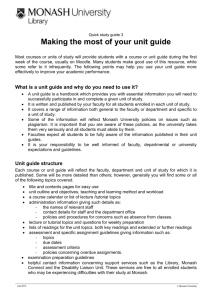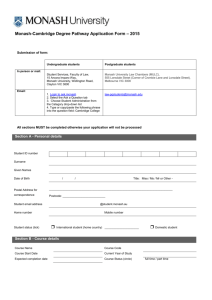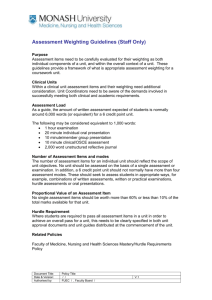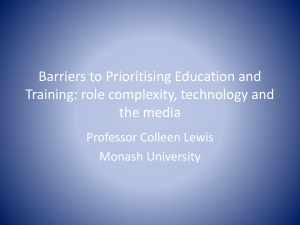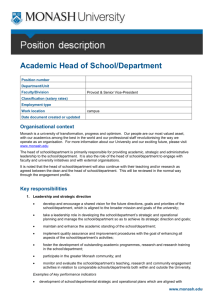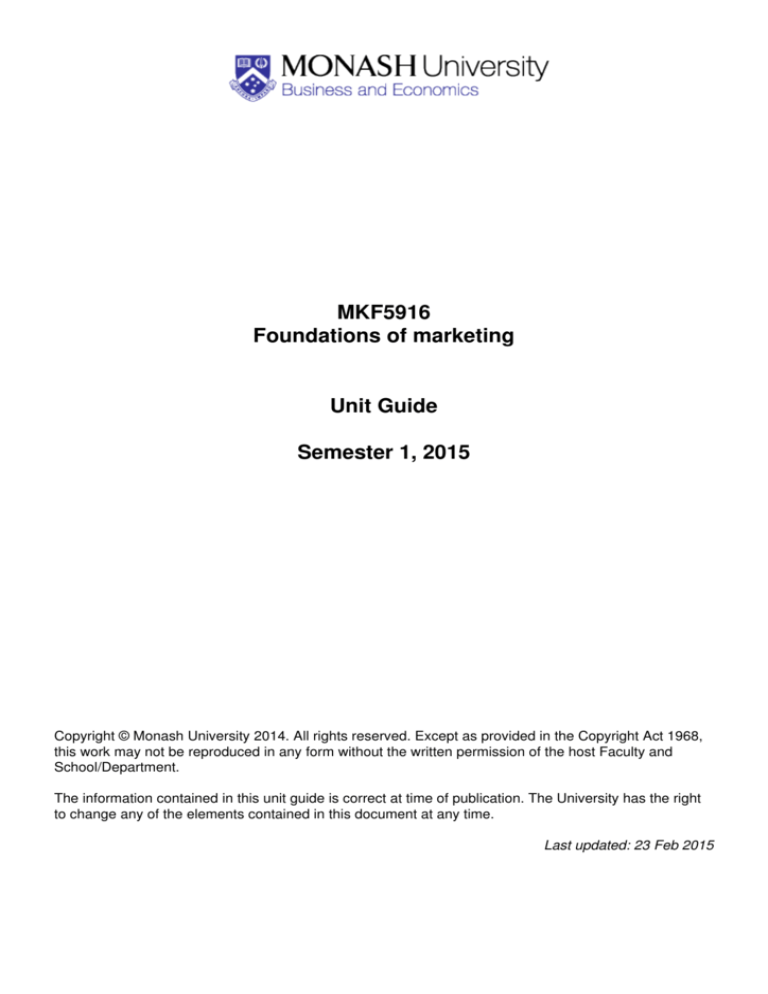
MKF5916
Foundations of marketing
Unit Guide
Semester 1, 2015
Copyright © Monash University 2014. All rights reserved. Except as provided in the Copyright Act 1968,
this work may not be reproduced in any form without the written permission of the host Faculty and
School/Department.
The information contained in this unit guide is correct at time of publication. The University has the right
to change any of the elements contained in this document at any time.
Last updated: 23 Feb 2015
Table of Contents
MKF5916 Foundations of marketing - Semester 1, 2015.......................................................................1
Mode of Delivery..............................................................................................................................1
Workload requirements....................................................................................................................1
Unit Relationships............................................................................................................................1
Prohibitions..........................................................................................................................1
Chief Examiner(s)........................................................................................................................................1
Campus Lecturer(s).....................................................................................................................................1
Caulfield...........................................................................................................................................1
Tutor(s)........................................................................................................................................................2
Caulfield...........................................................................................................................................2
Your feedback to Us....................................................................................................................................2
Previous Student Evaluations of this Unit....................................................................................................2
Academic Overview...................................................................................................................................3
Learning Outcomes.........................................................................................................................3
Unit Schedule.............................................................................................................................................4
Teaching Approach..........................................................................................................................5
Assessment Summary.....................................................................................................................5
Hurdle Requirements...........................................................................................................5
Second marking...................................................................................................................6
Return of final marks............................................................................................................6
Assessment criteria..............................................................................................................6
Assessment Requirements......................................................................................................................7
Assessment Tasks...........................................................................................................................7
Assessment task 1...............................................................................................................7
Assessment task 2.............................................................................................................12
Examination(s)...........................................................................................................................................13
Examination 1................................................................................................................................13
Learning resources....................................................................................................................................14
Feedback to you........................................................................................................................................14
Returning assignments..............................................................................................................................14
Assignment submission.............................................................................................................................14
Online submission.........................................................................................................................14
Prescribed text(s) and readings.....................................................................................................14
Recommended text(s) and readings..............................................................................................14
Other Information....................................................................................................................................15
Policies..........................................................................................................................................15
Graduate Attributes Policy.................................................................................................15
Student Charter.........................................................................................................................................15
Student services........................................................................................................................................15
Monash University Library.........................................................................................................................15
Moodle 2....................................................................................................................................................15
Disability Liaison Unit................................................................................................................................16
MKF5916 Foundations of marketing - Semester 1, 2015
Marketing activities undertaken by business and non-business organisations; value exchange concepts
and processes; the marketing concept from a strategic and applied perspective; development of
corporate and marketing strategic plans; analysis of an organisation's SBUs, product strategies and
product development; use of marketing decision making tools at both an applied and strategic level;
distribution, pricing and communication mix strategies; services marketing, individual and organisational
buyer behaviour, marketing research and market analysis; marketing management, implementation and
control processes and procedures.
Mode of Delivery
• Caulfield (Off-campus)
• Caulfield (Evening)
Workload requirements
Minimum total expected workload to achieve the learning outcomes for this unit is 144 hours per
semester typically comprising a mixture of scheduled learning activities and independent study.
Independent study may include associated readings, assessment and preparation for scheduled
activities. The unit requires on average three/four hours of scheduled activities per week. Scheduled
activities may include a combination of teacher directed learning, peer directed learning and online
engagement.
See also Unit timetable information
Unit Relationships
Prohibitions
MKX9550, MKX5955, MKX9160
Chief Examiner(s)
Dr Margaret Matanda (First semester)
Professor Hean Tat Keh (Second semester)
Campus Lecturer(s)
Caulfield
Dr Margaret Matanda
Contact hours: before and after class - or by appointment
1
MKF5916 Foundations of marketing - Semester 1, 2015
Tutor(s)
Caulfield
Dr Margaret Matanda
Contact hours: 16.00 to 17.00 hrs before Class and after class. You can also make an appointment
Your feedback to Us
Monash is committed to excellence in education and regularly seeks feedback from students, employers
and staff. One of the key formal ways students have to provide feedback is through the Student
Evaluation of Teaching and Units (SETU) survey. The University’s student evaluation policy requires that
every unit is evaluated each year. Students are strongly encouraged to complete the surveys. The
feedback is anonymous and provides the Faculty with evidence of aspects that students are satisfied
and areas for improvement.
For more information on Monash’s educational strategy, see:
www.monash.edu.au/about/monash-directions/ and on student evaluations, see:
www.policy.monash.edu/policy-bank/academic/education/quality/student-evaluation-policy.html
Previous Student Evaluations of this Unit
If you wish to view how previous students rated this unit, please go to
https://emuapps.monash.edu.au/unitevaluations/index.jsp
2
Academic Overview
Learning Outcomes
The learning goals associated with this unit are to:
1. examine the role and influence of marketing in the context of the modern business
2. explain the key concepts, models and theories upon which the practice of marketing is based
3. apply key concepts, models and theories in the development of marketing plans and marketing
planning
4. assess the marketing challenges facing firms in a more competitive global market place.
3
Unit Schedule
Week
Activities
0
Assessment
No formal assessment or activities are
undertaken in week 0
1
ï§ Lecture 1: Introduction to Unit and Assessment;
please note that there will be a Tutorial in
Defining Marketing and Value Exchange ï§ Tutorial 1: Week 1
Overview of assignments, Marketing Plan introduction
ï§ Forming Teams
2
ï§ Lecture 2: Marketing Strategy and Competitive
Advantage (Overview of Lecture & Application) ï§
Tutorial 2: The Evolving role of marketing
(Presentation of Readings & Application) ï§ Market
Plan Discussion: Marketing Plan structure
3
ï§ Lecture 3: Capturing Marketing Insights (Marketing
Research) (Overview of lecture & Application) ï§
Tutorial 3: Marketing Strategy and Competitive
Advantage (Presentation of Readings & Application).
ï§ Market Plan Discussion: Situation Analysis
4
ï§ Lecture 4: Connecting with Customers: Consumer
Behaviour (Overview of lecture & Application) ï§
Tutorial 4: Capturing Market Insights (Presentation of
Readings & Application) ï§ Market Plan Discussion,
Situation Analysis Cont'd.
5
Part I of the Marketing Plan assignment
ï§ Lecture 5: Market Segmentation and Targeting
due at the beginning of tutorial
(Overview of lecture & Application) ï§ Tutorial 5:
Consumer behaviour (Presentation of Readings &
Application) ï§ Market Plan Discussion: Target Market
6
ï§ Lecture 6: Brand Strategy, Positioning Strategy
(Overview of lecture & Application) ï§ Tutorial 6:
Market Segmentation and Targeting (Presentation of
Readings & Application) ï§ Market Plan Discussion:
Value Proposition
7
ï§ Lecture 7: Products and Services Strategy, Product
Life Cycleâ Brand strategy and positioning strategy
(Overview of lecture & Application) ï§ Tutorial 7: Brand
Strategy, Positioning Strategy (Presentation of
Readings & Application) ï§ Market Plan Discussion:
Marketing Mix Tactics
8
ï§ Lecture 8: New Product Development, Pricing
Strategy (Overview of lecture & Application ï§ Tutorial
8: Product and Services Strategy, New Product
Development) (Presentation of Readings &
Application) ï§ Market Plan Discussion: Marketing Mix
Tactics Cont'd.
9
ï§ Lecture 9: Supply Chain or Distribution Strategy
(Overview of lecture & Application) ï§ Tutorial 9:
Pricing strategy (Presentation of Readings &
Application) ï§ Market Plan Discussion:
Implementation and control
4
Unit Schedule
10
ï§ Lecture 10: Integrated Marketing Communications
(IMC) Strategy, Part I (Overview of lecture &
Application) ï§ Tutorial10: Distribution strategy
(Presentation of Readings & Application) ï§ Market
Plan Discussion: Putting it all together
11
ï§ Lecture 11: Integrated Marketing Communications
(IMC) Strategy, Part II (Overview of lecture &
Application) ï§ Tutorial 11: IMC strategy (Presentation
of Readings & Application)
12
ï§ Lecture 12: Global Marketing (Overview of lecture & Part II of the Marketing Plan assignment
Application) ï§ Unit Review
due at the beginning of tutorial
SWOT VAC
No formal assessment is undertaken
SWOT VAC
Examination period
LINK to Assessment Policy:
http://policy.monash.edu.au/policy-bank/
academic/education/assessment/
assessment-in-coursework-policy.html
Teaching Approach
Lecture and tutorials or problem classes
"This teaching and learning approach provides facilitated learning, practical exploration and peer
learning."
Assessment Summary
Within semester assessment: 60%
Examination: 40%
Assessment Task
Value
Due Date
Developing a Marketing
Plan
45% in total. Part 1 = 15%, Part I: Due at the start of your tutorial in
Part 2 = 30%
Week 5; Part II - due at start of tutorial in
Week 12
Tutorial Presentation and
Participation
15%
Students will be given a choice of topics and
delivery dates during the 2nd tutorial
Examination 1
40%
To be advised
Hurdle Requirements
There is a hurdle requirement in this unit.
The learning outcomes in this unit require students to demonstrate in the individual summative
assessment task a comprehensive understanding of the topics covered in the unit. This is demonstrated
by the requirement that the student must attain a mark of at least 50% in the final summative
assessment task.
5
Unit Schedule
A student’s final mark is normally the sum of the marks obtained in all of the individual assessment items
in the unit. Where a student fails the unit solely because of failure to satisfy the hurdle requirement a
mark of 48 will be returned for the unit.
The individual summative assessment task is the final exam
Second marking
Where an assessment task is given a fail grade by an examiner, that piece of work will be marked again
by a second examiner who will independently evaluate the work, and consult with the first marker. No
student will be awarded a fail grade for an assessment task or unit without a second examiner confirming
the result.
Note: Exceptions to this are individual pieces of assessment contributing 10% or less of the final mark,
unless the total of such pieces exceeds 30% of the final mark.
Return of final marks
Faculty policy states that 'the final mark that a student receives for a unit will be determined by the Board
of Examiners on the recommendation of the Chief Examiner taking into account all aspects of
assessment'.
The final mark for this unit will be released by the Board of Examiners on the date nominated in the
Faculty Calendar. Student results will be accessible through the my.monash portal.
Assessment criteria
Assessment Criteria Grading Descriptors available at:
http://www.buseco.monash.edu.au/esg/agu/policies/assessment.html.
6
Assessment Requirements
Assessment Tasks
•
Assessment task 1
Title:
Developing a Marketing Plan
Due date:
Part I: Due at the start of your tutorial in Week 5; Part II - due at start of tutorial in Week 12
Details of task:
The written assignments in this unit consist of the development of a marketing plan in
pairs of students. The assignment is divided into two staging posts which act as
assessment milestones. In total, the marketing plan will be up to 6000 words. Marks are
awarded for quality, not quantity, of work. Any excess over 6000 words will not be marked,
just as an over-long document in the workplace tends not to be read. This word constraint
means that careful selection and use of marketing concepts, market data and strategy
formulation must be considered.
In preparing the plan, you should choose an Australian company, organisation, or
strategic business unit about which you can find information, or with which you have some
familiarity. As a general guideline, it is easier to access information about publicly traded
organizations than about private organizations. Furthermore, if you choose to do your
marketing plan for a large company comprising several separate SBUs or divisions. Your
plan should focus on only ONE of these SBUs, otherwise it will be unmanageable.
This Marketing Plan assignment is an exercise in applying the marketing concepts,
frameworks, and theories that you will learn in this Unit to real-world organizations and
situations. Equipped with the knowledge from this unit, you will be analysing available
company and market data to draw conclusions about the current state of the organisation
and to make recommendations about its future.
Above all, the assignment is designed to build your strategic marketing thinking skills
and to encourage you to think critically and analytically - skills of high value in the
real business world. Note that the Marketing Plan assignment is not an exercise in
collecting large amounts of data; quality of work, not quantity of output.
Finally, if you are using the company you work for as a basis for this plan, please be
aware that some managers are very sensitive about the data contained in a marketing
plan. Often they will be unwilling to release this data, or to allow you to use it if you
already have it. Monash University assures you that the information will be used for no
purpose other than to assess your work in this unit. You may disguise the company and
the data. If you decide to disguise the company or to alter existing figures, you must
ensure that you have given what is needed to accurately and completely assess the
quality of your thinking in developing the plan.
Part I of the Plan (15%)
This part covers the Situation Analysis and Goals sections of the Marketing Plan.
Assessment Requirements
Situation Analysis section includes a Company Overview and a Market overview
7
Assessment Requirements
subsections.
Word limit - 3000 words
Due At the start of the Tutorial in week 5. (A soft copy submitted before the tutorial
on Moodle through TurnitIn)
Part II of the Plan (30%)
This part covers the remaining sections of the marketing plan, including the Customer
Segmentation section (Target Market and Value Proposition), the Strategies section
(Product/Service, Brand, Price, Incentives, Communications, and SCM), and the
Implementation and (Evaluation) Control sections.
Word limit guide: around 3000 words.
Due: Hard Copy due at the START of your Tutorial in Week 12 (A soft copy
submiited before the tutorial on Moodle through TurnitIn)
The Marketing plan and its requirements will be discussed at great length during each
week's tutorials. These discussions will give you significant insight into what information
and critical thinking is required for each step of the process.
Word limit:
no more than 6000 words
Weighting/Value:
45% in total. Part 1 = 15%, Part 2 = 30%
Estimated return date:
Feedback on each part of the Marketing Plan will be provided within two weeks of
submission date. All or some assignments will be retained and may be subject to a
plagiarism check by the University.
Criteria for marking:
PART 1
Situation Analysis: Company/SBU
Overview (30%)
Poor
Fair Good
Very
Excellent
Good
♦ Clearly defined company/SBU and the
business they are in
♦ A clear assessment of the key
strategic assets and competencies of
the SBU, as well as its market position
and marketing mix
♦ A clear and concise summary of the
SBU main strengths and weaknesses
Situation Analysis: Market Overview
Poor
(40%)
Fair
Good
Very Excellent
Good
♦ A clear indentification and overview of
industry in which the SBU operates.
8
Assessment Requirements
♦ A clear identification of the main
external environmental developments
and trends (e.g. economic,
technological, legal etc.) impacting or
likely to impact the SBU
♦ A clear overview of the market in
which the SBU operates. A clear
identification of the main external
environment developments and trends
(e.g., economic, technological, legal,
etc.) impacting or likely to impact the
SBU
- Customers (or Buyers)
- Collaborators (such as suppliers)
- Competitors (direct rivals, new
entrants, and substitutes)
♦ A clear and concise summary of the
main threats and opportunities posed
by the market forces and the external
environment
Goals (15%)
Poor
Fair
Good
Very Excellent
Good
♦ A clearly identified goal, with specific
sub-goals, as well as performance and
temporal benchmarks
♦ Goals logically follow from the
preceding situation analysis
Structure and style (15%)
Poor
Fair
Good
Very Excellent
Good
♦ Formatting and style of the document,
♦ Citation and Reference list accuracy
and style
♦ Information was conveyed in a
readable, well organised and logical
9
Assessment Requirements
fashion (logical flow, spelling,
punctuation, grammar)
Overall
Poor
Fair
Good
Very Excellent
Good
♦ Quality of submission
Grade
PART II
Strategy: Target Market and Value
Proposition (30%)
Poor
Fair Good Very
Excellent
Good
♦ A clearly identified target market with
analysis of the compatibility and
attractiveness of the target customer
segments. If any change to current
target market is proposed, the change
should be well supported
♦ A clearly identified value proposition
and positioning statement for target
market. Any changes proposed should
be well supported.
♦ Clear and logical link between
recommended target market and
value propositions and previous
(situation analysis, goal) part of the
marketing plan.
♦ Appropriate use of concepts/models
covered in class
Tactics (40%)
Poor
Fair
Good
Very Excellent
Good
♦ A clear overview and analysis of the
current marketing mix of the SBU
10
Assessment Requirements
♦ A clear and well supported
recommendations for future direction
♦ Clear and logical link between
recommended tactics and previous
sections (situation analysis, goal,
strategy) of the marketing plan.
♦ Appropriate use of concepts/models
covered in class & discussions
Implementation, Evalution, and Control
(15%)
Poor
Fair
Good
Very Excellent
Good
♦ A clear and feasible implementation
plan, feasible and measurable criteria
for evaluation and control.
Structure and style (15%)
Poor
Fair
Good
Very Excellent
Good
♦ Formatting and style of the document,
♦ Citation and Reference list accuracy
and style
♦ Information was conveyed in a
readable, well organised and logical
fashion (logical flow, spelling,
punctuation, grammar)
Overall
Poor
Fair
Good
Very Excellent
Good
♦ Quality of submission
Grade
Submission details:
A hard copy of each assignment should be submitted to your Tutor, appropriately
bound in a professional manner. Please ensure that an assignment cover page is
attached to the assignment, completed by both students submitting the
assignment. A word count must be provided on the front cover of each
submission. The word count should be based on the body of the plan (excluding
11
Assessment Requirements
executive summary, table of contents, references, and any appendices).
A Marketing Plan is a decision making document submitted to senior management
in a company to secure funding for your marketing strategies. Therefore it must
be presented in a professional manner, and carefully edited for spelling and
grammatical errors.
Penalties for late lodgement:
To request an assignment extension, complete and submit the application for ‘Extension
of Time for Submission of an Assessment Task form’ to the examiner/lecturer/tutor at
least two working days (48 hours) before the due date of the assignment.
Extension application form can be found online on faculty “Current Student” page:
http://www.buseco.monash.edu.au/student/
•
Where work is submitted after the due date without an approved extension, a penalty of
10% of the mark allocated to each assignment task will be deducted for each day or part
of a day that the assignment is late.
Assessment coversheet:
Work submitted for assessment must be accompanied by a completed copy of the
Faculty Cover Sheet which has been signed by the student. NO assignment will be
accepted or marked if it is not accompanied by a signed Assignment Cover Sheet
Assessment task 2
Title:
Tutorial Presentation and Participation
Due date:
Students will be given a choice of topics and delivery dates during the 2nd tutorial
Details of task:
♦ Presentation of the Readings is assigned for respective weeks (each student will
present once during the semester, in a team with one or two other students).
♦ The assessment will reflect the extent to which the presenting team reviewed the
key ideas from the Readings in a succinct manner, provided a critical analysis of
these ideas, and linked them to relevant marketing theory and real-life examples.
♦ A critical approach to the ideas in the articles is highly encouraged (rather than a
mere repetition or summary of the Readings). Students are also encouraged to
illustrate, whenever possible, their arguments and the key ideas from the readings
with examples from marketing practice.
♦ Finally, and most importantly, the presenting team should strive to engage the
class in a lively discussion of the presented ideas, by posing questions and
challenging their classmates to think critically.
Weighting/Value:
15%
Estimated return date:
Feedback to the presenting team will be provided one week after the presentation date.
Feedback on tutorial and class participation throughout the semester can be obtained by
contacting the Unit Coordinator at the end of the respective exam period.
Criteria for marking:
Content (70%)
Poor Fair Good Very Excellent
Good
12
Assessment Requirements
♦ Comprehension of main article ideas;
ability to present main points of articles in a
clear and succinct manner
♦ Relation to concepts and theory studied in
unit
♦ Application to practice (e.g., examples,
illustrations)
♦ Creativity and critical approach (e.g., going
beyond what are in the articles)
Structure and Style (30%)
♦ Oral communication (clarity, style)
♦ Visual aids, handouts
♦ Involvement of class in discussion
♦ Overall
♦ Overall Quality of the presentation
Grade
Examination(s)
• Examination 1
Weighting:
40%
Length:
2 hours
Type (open/closed book):
Closed book
Hurdle requirements:
There is a hurdle requirement in this unit.
The learning outcomes in this unit require students to demonstrate in the individual
summative assessment task a comprehensive understanding of the topics covered in the
unit. This is demonstrated by the requirement that the student must attain a mark of at
least 50% in the final summative assessment task.
A student’s final mark is normally the sum of the marks obtained in all of the individual
assessment items in the unit. Where a student fails the unit solely because of failure to
satisfy the hurdle requirement a mark of 48 will be returned for the unit.
13
Assessment Requirements
The individual summative assessment task is the final exam.
Electronic devices allowed in the exam:
None.
Learning resources
Monash Library Unit Reading List (if applicable to the unit)
http://readinglists.lib.monash.edu/index.html
Feedback to you
Types of feedback you can expect to receive in this unit are:
• Informal feedback on progress in labs/tutes
• Graded assignments with comments
Returning assignments
Students can expect assignments to be returned within two weeks of the submission date or after
receipt, whichever is later.
Assignment submission
Online submission
If Electronic Submission has been approved for your unit, please submit your work via the learning
system for this unit, which you can access via links in the my.monash portal.
Prescribed text(s) and readings
Kotler, Philip and Kevin Lane Keller, (2012) "Marketing Management," 14e Global Edition,
ISBN: 13:978-0-273-75336-0. This book provides the primary theoretical and conceptual background for
this unit.
Recommended text(s) and readings
A list of readings will be identified and placed on Moodle. You can access these readings through the
library databases and via the ‘Reading List’ link on the library home page. The readings will form the
foundation of your tutorial preparation. The key readings are examinable. Quite apart from familiarising
yourself with the large number of marketing journals available through the library, you should also keep
abreast of current developments through the local press such as Australian Financial Review, the Age,
the Australian, Business Review Weekly, AdNews, etc.
14
Other Information
Policies
Monash has educational policies, procedures and guidelines, which are designed to ensure that staff and
students are aware of the University’s academic standards, and to provide advice on how they might
uphold them. You can find Monash’s Education Policies at:
www.policy.monash.edu.au/policy-bank/academic/education/index.html
Key educational policies include:
• Student Academic Integrity Policy and Student Academic Integrity: Managing Plagiarism and
Collusion Procedures ;
• Assessment in Coursework Programs;
• Special Consideration;
• Grading Scale;
• Discipline: Student Policy;
• Academic Calendar and Semesters;
• Orientation and Transition; and
• Academic and Administrative Complaints and Grievances Policy.
Graduate Attributes Policy
http://www.policy.monash.edu/policy-bank/academic/
education/management/monash-graduate-attributes-policy.html
Student Charter
www.opq.monash.edu.au/ep/student-charter/monash-university-student-charter.html
Student services
The University provides many different kinds of support services for you. Contact your tutor if you need
advice and see the range of services available at http://www.monash.edu.au/students
Monash University Library
The Monash University Library provides a range of services, resources and programs that enable you to
save time and be more effective in your learning and research. Go to www.lib.monash.edu.au or the
library tab in my.monash portal for more information.
Moodle 2
All unit and lecture materials, plus other information of importance to students, are available through the
virtual learning environment Moodle site. You can access Moodle via the my.monash portal.
Where to go for help
If you're stuck, confused or simply not sure how to approach Moodle, there are a number of Moodle
resources that you can tap into.
15
Other Information
Disability Liaison Unit
Students who have a disability or medical condition are welcome to contact the Disability Liaison Unit to
discuss academic support services. Disability Liaison Officers (DLOs) visit all Victorian campuses on a
regular basis.
• Website: http://www.monash.edu/equity-diversity/disability/index.html
• Telephone: 03 9905 5704 to book an appointment with a DLO;
• Email: dlu@monash.edu
• Drop In: Equity and Diversity Centre, Level 1, Building 55, Clayton Campus.
16

